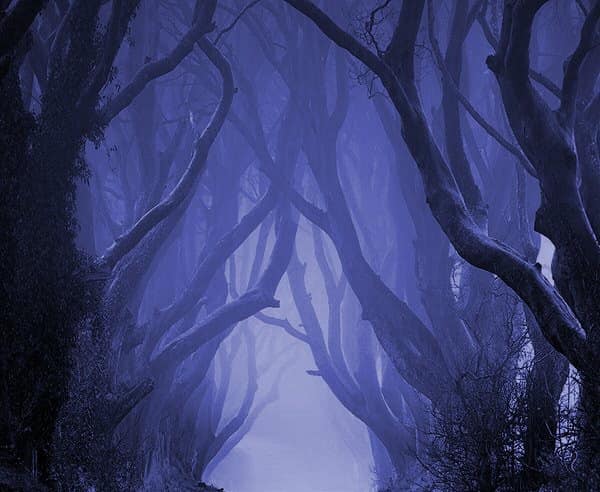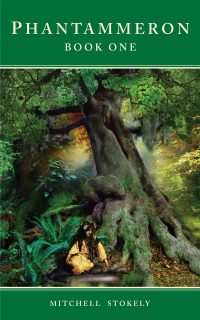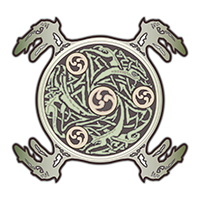I believe our minds work unconsciously quite often to do and achieve things we often don’t see or comprehend. And I have seen that in my own writing. Phantammeron Book One, my fantasy novel, is now published and complete (Oct. 2015). However, as I have begun to do additional rereading’s and reviews of the novel (primarily looking for additional grammatical errors for a possible re-edition when book two is released) I’ve begun to notice something very odd about the narrative and plot.
When I wrote the Phantammeron in 2014-2015, I had combined my older story outlines from 1989 with a newer overall plot structure needed to support the larger 12-book series structure planned. But, though the novel has many hidden mysteries and carefully constructed threads and events (many of which carry into book two), I’ve begun to notice very odd mirrors of things…reflections of plots and symbols, and coincidences in the story that were not intended. And these reflect some strange mystery about the unintended “mythic nature” of what I tried to create by writing the Phantammeron, an early reflection on my own personal myths and symbols I started building 25 years ago.

But there are many hidden ideas in the book I never planned or intended. I want to share a list of things here as I find them fascinating. I didn’t plan them nor did I intend them to lead or connect with anything beyond a single moment in the narrative. For example, in the novel where the Shade finds her father the Eternal Night and learns of the true whereabouts of the Wings of Night….that whole design was an intentional twist that came to me towards the end of the writing cycle. It was my intention to lay out several mysteries like that and resolve them as subplots to the larger story of the making of the Phantammeron world by the Creator and the releasing of the Sacred Waters into Phantaia that was the main story. But many odd connections I see have come from these subplots to mysteries and things in the book that I never planned but have now bubbled up. In the first chapters of the book the Wings of Night are mentioned but oddly finish the last chapter of the book. That type of mirror I’ve seen now continues through the book. For example, the destruction of the forest initially by Yana is reflected by the discovery of its living beauty by Ana at the same point in the second half of the book. Agapor’s seeking of his father is paralleled by the Shadow seeking his father with exact opposite results. The sleeping An is paralleled by her sleeping daughter Ana under the gardens of Abrea. The dark pool scene by the Limitless Void in the beginning of the book is replicated exactly by the same dark pool Ana visits at the end. The Endless Night saying he hears the spirit of his dead son, the Shadow, crying is described in the last chapter when the Shadow cries out for his father right before he perishes when burned by the light of the One Tree. That wasn’t intended. The cloud of the Nothingness telling the Limitless Void he must sacrifice his children for his help is the exact same request given to Agapor later. The threat the Nothingness told the Void, that if he failed he would “suffer the same fate as they” came true in the fact the evil twins trapped in the gray misty Beyond which was a prison to them the Void spirit also experienced later as he became trapped in the “dark ring” which is also described as a prison. I honestly didn’t plan that idea, folks.
But it gets better!!
Other stuff in the novel I did not plan include the appearance of the shining cauldron in Agapor’s dreams in the 4th chapter also appears in the 4th to last chapter in the book. There the event has the exact opposite effect as the Secret Spring hands a shining cauldron to Ana as a gift while her father Agapor in the earlier chapter just sees it in a dream as a temptation and mystery. The hiding of the mountains of heaven in chapter two by the Shadow’s wings when he cloaked the world for evil purposes in chapter 2 is the exact opposite of his daughter the Shade hiding heavens lights in the 2nd to last chapter when she makes the nighttime skies. Again, I didn’t plan that parallel. When the Shade is freed from her slavery to Agapor in Phantaia she briefly rises up to slay him but can’t. That is the opposite of her brother the Shadow who wants to slay him but has never tried, now being oddly passive and his sister active. Another opposing theme.
I really surprising discovery was parallels between the violent scene of the Dreaming Seas vs Agapor in the 3rd chapter becoming the exact opposite of Ana releasing the waters in Abrea and Agapor lying passive and injured in the garden watching the gardens and forest regrow in beauty around him as the rains fall from the storm Yana. That is its opposite effect. By the way, when I reread that scene at the end it was sadder and more profound than planned (I actually shed a tear rereading that), as evil Agapor was the only living being left to witness the beauty of Phantaia’s rebirth. Yet he saw it as a character that had disrupted the seas and the world and destroyed so much of it. He now witnessed its resurrection. Amazing! There is some additional meaning there I may use in later books, as it’s a strange reflection of God and the creator remaking a dying world, a story Mankind has rarely visited but which my books will harken too, repeatedly.
The mingling of the Maiden Tree whose silver lights merging with The One Tree’s golden light later in the book wasn’t planned and oddly parallels Tolkien’s concept of the light of the Two Trees he briefly described in the Silmarillion. But I couldn’t have planned that as Phea, queen of the Maiden Trees, was a last-minute concept thrown together. Some primitive myth must exist there of symbol of something tied to the Sun and Moon and twilight which was a subliminal idea I did place on Book One for the reader to grasp, but not being what Tolkien envisioned at all.
The story of Agapor searching in the ancient libraries of Oblivion was just an excuse to do something imaginative as I’ve always wanted to write about ancient Libraries or Halls of Records which the Egyptians in myth are said to have created. But it turns out, after I reread what I wrote, where Agapor had discovered why his Uncle, the Limitless Void, had destroyed his own children for power in the libraries, that this theme was the secret reason he went searching in the first place for information. And the solving of his life’s purpose and riddle was NOT the real reason for him going there, which I had described (he had been sitting in a tower overlooking the Great Beyond and was thinking of Ana his daughter and his vow to the Nothingness to slay her). And so, he had obviously thought of his uncles vow as well (not himself as I intended) and so went looking for information, with intuition of discovering what he already knew, but I the author had not. Eerie story parallel’s, indeed! That was something not fully intended by me in the book which was strangely revealed later to me. It’s like the book wrote what it needed to write despite its author!
The plot device of the Shade’s love for Agapor did evolve till later, and was planned by me. But her appearance became a mirror back on itself many times in the novel, which I never intended. For example, earlier in the book I describe how she came to Agapor at his bedside while he was having nightmares about his sister. Later at the end, the Shade rescues Agapor and lays with him again to save him, but this time he’s haunted by his vow for his daughter’s life which isn’t a crisis of romantic love but the life of his child. He then sacrifices himself in the Great Beyond at the end of the books, but not before the Shade comes to him. It’s then Agapor finally expresses his long-held love for her, which I felt he never truly had. But, in the end the book spoke to me, and revealed that truth after the story was written. That wasn’t planned, but became a strange fulfillment of those two other plots. Again, that was not fully planned or understood by me till now as a form of unresolved love finally fulfilled through the Shade’s enduring love. It wouldn’t mean much later in the larger story, until I realized the mirrors it created to plots in prior chapters. I didn’t intend any of that.
Odd that all that also is a larger “reflection” of the mirror-like quality of the first and second halves of the book, because in that too is some hidden truth about the novel I never saw before. All these concepts solidified in my mind the Celtic Nature of my writing, of opposing and conflicting opposites. It was very much like the Celtic vision of an ancient tree, half of which is on fire. Often what we write reflects, not just our mythological selves, but something inherent to the creation or art itself.
In the book the Witch Anissa tried to save the Shadow like the Shade saved Agapor, but she does the opposite by cutting his cheek with her nails for blood then offering to save him but for a price…the dark ring. That’s the opposite of the Shade’s love where she bleeds to save Agapor in the ending chapter. Here again is some secret subliminal opposing play at work, another yin-yang cosmological mystery there in hiding that was not planned. What is the meaning of blood and love there? I’m still trying to understand what in the world I was suggesting there.
Other odd things I never planned but have come out of the story include the black pool and the witch Anissa (which you will learn in book two) as being an exact OPPOSITE character set and counter plot to Ana and the Sacred Pool in Abrea. This perfect dual match has just begun to come out of the hidden inner life of the book and which I never saw before except in one very planned way that hides one of the secrets to the story not revealed yet. But I never saw Anissa as being the “anti-mother” and dark pool character to Ana the mother of the good pool in Abrea. It’s very interesting, as that comes out now in book two. There are other strange parallels I have found. The Murgala or Black Roses in the garden in the Phantammeron were at first a fairy tale I had read and jotted down in an outline. I later conceived of them as coming from tears from the Endless Night as a representation of his rejected love for the Secret Spring. I had trouble deriving the “secret meaning” of that as a subplot but later found a solution. But it wasn’t till later I realized they would form the odd reason for the death of the Secret Spring’s child which she later denies. And they later formed the basis for the Shadows power he regains at the end. That wasn’t planned either by me as a writer. It’s just came from the imagery as the Shadow unfurled his wings to Ana and she watched the Black Roses grow around him. But that effect has implied a new meaning for the Black Roses in the book I never saw before…..that they in effect claim the gardens and Phantaia as secretly born of darkness, too. And that is a perfect symbol of the strange fact the Nothingness tells Ana in the pit…..that the Creator was his child, and his “dark seed is in all the world’s children”. Again, never structured that idea. But it’s come out of the story now. And it mirrors again other concepts in various layers of the novel that are hidden even to me.
The book has truly become a “self-reflecting mirror of itself” now in a strange eerie way which I never planned or intended. It’s not that there aren’t still loose ends but most reflect “back on earlier” plots in the book itself, which I found odd as I had not planned that level of structure. This goes back to what I’ve been saying about “dream writing”, Mythopoeia and the letting go of personal needs in fictional story and the embrace of the unconscious spirit in myth. It seems our minds have some VAST undiscovered country that has meaning and structure we cannot grasp. We have some other life inside us going on all the time even in our careers and waking life that drives another story and meaning entirely that derives from both chaos and order. And it’s that aspect of writing and ourselves I wanted you all to see in my own books and which has started to come forward in the mythology of fairy tale and story that flows throughout the Phantammeron.
– the Author



